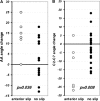Subaxial subluxation after atlantoaxial transarticular screw fixation in rheumatoid patients
- PMID: 19337758
- PMCID: PMC2899668
- DOI: 10.1007/s00586-009-0945-5
Subaxial subluxation after atlantoaxial transarticular screw fixation in rheumatoid patients
Abstract
The most common cervical abnormality associated with rheumatoid arthritis (RA) is atlantoaxial subluxation, and atlantoaxial transarticular screw fixation has proved to be one of the most reliable, stable fixation techniques for treating atlantoaxial subluxation. Following C1-C2 fixation, however, subaxial subluxation reportedly can bring about neurological deterioration and require secondary operative interventions. Rheumatoid patients appear to have a higher risk, but there has been no systematic comparison between rheumatoid and non-rheumatoid patients. Contributing radiological factors to the subluxation have also not been evaluated. The objective of this study was to evaluate subaxial subluxation after atlantoaxial transarticular screw fixation in patients with and without RA and to find contributing factors. Forty-three patients who submitted to atlantoaxial transarticular screw fixation without any concomitant operation were followed up for more than 1 year. Subaxial subluxation and related radiological factors were evaluated by functional X-ray measurements. Statistical analyses showed that aggravations of subluxation of 2.5 mm or greater were more likely to occur in RA patients than in non-RA patients over an average of 4.2 years of follow-up, and postoperative subluxation occurred in the anterior direction in the upper cervical spine. X-ray evaluations revealed that such patients had a significantly smaller postoperative C2-C7 angle, and that the postoperative AA angle correlated negatively with this. Furthermore, anterior subluxation aggravation was significantly correlated with the perioperative atlantoaxial and C2-C7 angle changes, and these two changes were strongly correlated to each other. In conclusion, after atlantoaxial transarticular screw fixation, rheumatoid patients have a greater risk of developing subaxial subluxations. The increase of the atlantoaxial angel at the operation can lead to a decrease in the C2-C7 angle, followed by anterior subluxation of the upper cervical spine and possibly neurological deterioration.
Figures





Similar articles
-
Cervical spine manifestations of rheumatoid arthritis: a review.Neurosurg Rev. 2021 Aug;44(4):1957-1965. doi: 10.1007/s10143-020-01412-1. Epub 2020 Oct 10. Neurosurg Rev. 2021. PMID: 33037539 Review.
-
Risk factors for development of subaxial subluxations following atlantoaxial arthrodesis for atlantoaxial subluxations in rheumatoid arthritis.Spine (Phila Pa 1976). 2010 Jul 15;35(16):1551-5. doi: 10.1097/BRS.0b013e3181af0d85. Spine (Phila Pa 1976). 2010. PMID: 20072093
-
Efficacy and durability of the titanium mesh cage spacer combined with transarticular screw fixation for atlantoaxial instability in rheumatoid arthritis patients.Spine (Phila Pa 1976). 2009 Oct 15;34(22):2384-8. doi: 10.1097/BRS.0b013e3181b04f1d. Spine (Phila Pa 1976). 2009. PMID: 19829251
-
Atlantoaxial transarticular screw fixation and posterior fusion using ultra-high-molecular-weight polyethylene cable.J Spinal Disord Tech. 2005 Oct;18(5):392-5. doi: 10.1097/01.bsd.0000167127.16576.02. J Spinal Disord Tech. 2005. PMID: 16189448
-
Rheumatoid arthritis of the craniovertebral junction.Neurosurgery. 2010 Mar;66(3 Suppl):83-95. doi: 10.1227/01.NEU.0000365854.13997.B0. Neurosurgery. 2010. PMID: 20173532 Review.
Cited by
-
C1 anterior arch preservation in transnasal odontoidectomy using three-dimensional endoscope: A case report.Surg Neurol Int. 2015 Dec 28;6:192. doi: 10.4103/2152-7806.172696. eCollection 2015. Surg Neurol Int. 2015. PMID: 26759737 Free PMC article.
-
Characteristics of idiopathic atlanto-axial subluxation: a comparative radiographic study in patients with an idiopathic etiology and those with rheumatoid arthritis.Eur Spine J. 2013 Jan;22(1):54-9. doi: 10.1007/s00586-012-2466-x. Epub 2012 Aug 10. Eur Spine J. 2013. PMID: 22878378 Free PMC article.
-
Minimally invasive anterior transarticular screw fixation and microendoscopic bone graft for atlantoaxial instability.Eur Spine J. 2012 Aug;21(8):1568-74. doi: 10.1007/s00586-012-2153-y. Eur Spine J. 2012. PMID: 22315033 Free PMC article.
-
Cervical spine manifestations of rheumatoid arthritis: a review.Neurosurg Rev. 2021 Aug;44(4):1957-1965. doi: 10.1007/s10143-020-01412-1. Epub 2020 Oct 10. Neurosurg Rev. 2021. PMID: 33037539 Review.
-
Considerations on "Endoscopic endonasal approach to the craniocervical junction: the importance of anterior C1 arch preservation or its reconstruction".Acta Otorhinolaryngol Ital. 2016 Jun;36(3):228-30. doi: 10.14639/0392-100X-927. Acta Otorhinolaryngol Ital. 2016. PMID: 27214835 Free PMC article. No abstract available.
References
-
- Agarwal AK, Peppelman WC, Kraus DR, Pollock BH, Stolzer BL, Eisenbeis CH, Jr, et al. Recurrence of cervical spine instability in rheumatoid arthritis following previous fusion: Can disease progression be prevented by early surgery? J Rheumatol. 1994;19:1364–1370. - PubMed
-
- Eleraky MA, Masferrer R, Sonntag VK. Posterior atlantoaxial facet screw fixation in rheumatoid arthritis. J Neurosurg. 1998;89:8–12. - PubMed
MeSH terms
LinkOut - more resources
Full Text Sources
Medical
Miscellaneous

